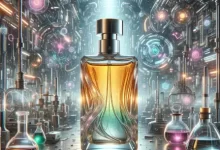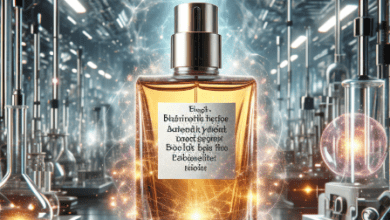Future Scent: How AI, Biotech & Sustainability Are Revolutionizing Fragrance
Beyond Perfume Bottles: Exploring the Cutting-Edge Innovations Shaping the Smells of Tomorrow

Abstract: The world of scent is undergoing a radical transformation, moving far beyond traditional perfumery. “Future Scent” encapsulates the convergence of artificial intelligence, advanced biotechnology, neuroscience, material science, and sustainability, fundamentally altering how scents are created, experienced, and integrated into our lives. This article delves deep into the groundbreaking innovations defining this new era: AI algorithms generating novel fragrance molecules and predicting consumer preferences; biotech companies engineering microbes and plants to produce sustainable, rare, or entirely new aroma compounds; neuroscientific research unlocking the profound link between scent, emotion, and memory for therapeutic and wellness applications; and the rise of smart devices delivering personalized, adaptive, and context-aware olfactory experiences. We explore how sustainability is no longer a trend but a core driver, pushing for carbon-negative materials, biodegradable formulations, and ethical sourcing. The implications extend far beyond luxury perfumes, impacting healthcare, mental wellbeing, immersive entertainment, smart homes, and even digital communication. Future Scent promises a world where fragrance is hyper-personalized, dynamically responsive, environmentally responsible, and deeply integrated into enhancing human experience and planetary health.
Body Content:
For millennia, humanity has been captivated by scent. From ancient incense rituals to the meticulously crafted perfumes of Grasse, fragrance has served as a marker of identity, a tool for seduction, a conduit for spirituality, and a powerful trigger for memory and emotion. Yet, the fundamental processes of discovering, extracting, blending, and delivering scents remained relatively unchanged for centuries. Today, we stand at the precipice of an olfactory revolution. The concept of “Future Scent” is not merely an evolution of perfumery; it represents a paradigm shift, driven by a potent convergence of disruptive technologies and a profound rethinking of scent’s role in our lives and its impact on our planet.
The traditional model relied heavily on natural extracts (often scarce, expensive, and environmentally taxing) and synthetic aroma chemicals (derived from petrochemicals), blended by master perfumers using intuition honed over decades. While artistry remains crucial, Future Scent introduces powerful new tools and perspectives:
1. Artificial Intelligence: The Digital Nose & Creative Partner
Artificial Intelligence is rapidly becoming an indispensable collaborator in the fragrance lab. Its impact is multi-faceted:
- Molecule Discovery & Generation: AI algorithms, trained on vast databases of known aroma molecules and their olfactory properties (odor profile, intensity, longevity), can now predict the scent of entirely novel molecular structures before they are synthesized. More impressively, generative AI models can design completely new molecules tailored to specific scent profiles (e.g., “a fresh oceanic note reminiscent of a stormy Arctic sea, with a hint of green apple and ozone”). This accelerates R&D exponentially, opening doors to olfactory territories previously unimaginable. Companies like IBM Research and startups like Osmo (backed by Google) are pioneering this space.
- Predictive Consumer Insights & Formulation: AI analyzes massive datasets – social media trends, consumer reviews, sales figures, cultural shifts, even weather patterns – to predict future fragrance preferences with remarkable accuracy. It can identify emerging scent families, preferred accords, and even regional variations. Furthermore, AI can assist perfumers in formulating new fragrances by suggesting combinations of ingredients that statistically align with desired consumer profiles or optimize for specific performance metrics (longevity, sillage, cost, sustainability score).
- Personalized Fragrance Creation: AI-powered platforms are emerging where consumers input preferences (likes, dislikes, memories, desired mood effects) or even provide a sample of their favorite scent. The AI then analyzes this data and either recommends existing perfumes or formulates a unique, bespoke fragrance blend. This hyper-personalization is a key pillar of Future Scent.
- Quality Control & Counterfeit Detection: AI algorithms trained on spectral data (like GC-MS) can detect minute inconsistencies in fragrance batches or identify counterfeit products with far greater speed and accuracy than human noses.
2. Biotechnology: Engineering Nature’s Palette Sustainably
Biotechnology offers solutions to some of perfumery’s oldest challenges: the scarcity and environmental impact of natural ingredients, and the reliance on petrochemical synthetics.
- Fermentation & Precision Fermentation: Microorganisms (yeast, bacteria, fungi) are genetically engineered to produce specific, high-value aroma molecules through fermentation. This mimics the natural production process (e.g., roses producing rose oil) but in controlled bioreactors, using sustainable feedstocks like sugar. Companies like Ginkgo Bioworks, Amyris, and Conagen are producing ingredients like patchouli, sandalwood, vanilla, and rose oil equivalents this way, offering consistent quality, scalability, and significantly reduced land/water use compared to traditional agriculture. Precision fermentation takes this further, engineering microbes to produce molecules not found in nature, creating entirely new scent experiences.
- Plant Cell Culture & Metabolic Engineering: Instead of harvesting entire plants, scientists grow undifferentiated plant cells in bioreactors and stimulate them to produce the desired fragrant compounds. This is particularly valuable for rare, slow-growing, or endangered species (e.g., certain orchids, oud-producing trees). Metabolic engineering directly tweaks the biochemical pathways within plants or microbes to enhance the yield of specific molecules or produce novel ones.
- Enzyme Technology: Specific enzymes can be used to biotransform readily available, inexpensive starting materials into valuable, complex aroma molecules with high purity and stereospecificity (important for scent quality), often under milder, more sustainable conditions than traditional chemical synthesis.
- Waste Valorization: Biotech processes are being developed to extract valuable aroma compounds from agricultural or food processing waste streams (e.g., citrus peels, coffee grounds, grape pomace), creating fragrance ingredients from what was once discarded, contributing to a circular economy.
3. Neuroscience & Psychophysics: Decoding Scent’s Impact on Mind and Body
Future Scent is deeply informed by a growing scientific understanding of how smell works and its profound effects on our neurology, psychology, and physiology.
- Mapping Olfaction: Research continues to unravel the complex mechanisms of odorant receptor binding, neural coding in the olfactory bulb, and the direct pathways linking the olfactory system to the amygdala (emotion) and hippocampus (memory). This knowledge helps explain why scents evoke such powerful, often subconscious, responses.
- Scent for Wellbeing & Therapy: Armed with neuroscientific insights, Future Scent applications are expanding into health and wellness. Calming lavender or uplifting citrus are just the beginning. Research explores specific scent molecules and blends for:
- Stress & Anxiety Reduction: Targeting pathways that modulate cortisol and promote relaxation.
- Cognitive Enhancement: Scents shown to improve focus, memory recall, or alertness.
- Sleep Improvement: Promoting relaxation and sleep onset.
- Appetite Modulation: Potential applications in weight management.
- Neurological Support: Exploring scents to stimulate appetite in dementia patients or manage symptoms in Parkinson’s disease.
- Mood Modulation & Emotional Design: Fragrances are being designed not just to smell pleasant, but to elicit specific, measurable emotional states – calm, energy, confidence, comfort – based on neuroscientific principles. This “emotional design” is crucial for applications in retail, hospitality, workspaces, and personal care.
- Quantifying Perception: Psychophysics studies help quantify subjective experiences like intensity, pleasantness, and perceived similarity between scents, providing crucial data for AI training and product development.
4. Smart Delivery & Context-Aware Olfaction: Scent When and Where You Need It
The static perfume bottle is being augmented and sometimes replaced by dynamic, responsive scent delivery systems:
- Micro-encapsulation & Controlled Release: Technologies allow scents to be embedded in textiles, packaging, or personal care products and released slowly over time or triggered by specific stimuli (heat, moisture, friction).
- Wearable Diffusers: Compact, personal devices (necklaces, wristbands, clips) allow individuals to carry and control their personal scent bubble, adjusting intensity or switching scents based on mood or context.
- Smart Home & Ambient Scenting: IoT-connected diffusers integrated with smart home systems can release scents based on the time of day, activity (e.g., waking up, relaxing, entertaining), incoming calendar events, or even synced with music or lighting to create multi-sensory experiences. They can also purify air simultaneously.
- Contextual & Adaptive Scenting: Future systems will use sensors (location, biometrics, calendar, even camera input) to infer user context and mood, automatically adjusting scent profiles. Imagine your car diffusing a focus-enhancing scent for your commute and switching to a relaxing one as you near home.
- Digital Olfaction Interfaces: While still nascent, research into devices that can capture, digitize, and transmit scent information (“smell-o-vision” or scent messaging) continues, potentially revolutionizing communication, entertainment (VR/AR), and even e-commerce (smelling a product online).
5. Sustainability & Ethics: The Non-Negotiable Foundation
Future Scent is inextricably linked with environmental and social responsibility. It’s a core driver, not just an afterthought:
- Biotech as an Eco-Solution: As mentioned, biotech-derived ingredients drastically reduce pressure on endangered plants, decrease land and water use, and avoid the pesticides and herbicides common in traditional agriculture.
- Green Chemistry: Developing synthetic pathways for aroma molecules that use renewable feedstocks, benign solvents, energy-efficient processes, and generate minimal waste.
- Circular Economy: Utilizing waste streams as raw materials, designing biodegradable fragrance molecules and delivery systems, and creating refillable/reusable packaging models.
- Carbon Footprint Reduction: Lifecycle assessments are becoming standard, pushing for carbon-neutral or even carbon-negative fragrance production and supply chains. This includes sustainable sourcing of remaining natural ingredients.
- Transparency & Traceability: Blockchain and other technologies are being explored to provide verifiable proof of ethical sourcing, fair trade practices, and sustainable production from farm (or bioreactor) to final product.
- Ethical Biotechnology: Ensuring responsible use of genetic engineering, addressing potential ecological impacts of engineered microbes, and maintaining biodiversity.
The Broader Implications: Scent Beyond the Bottle
The impact of Future Scent extends far beyond the perfume counter:
- Functional Fragrances: Scent integrated into cleaning products, paints, textiles, and packaging with specific functional benefits (antimicrobial properties, mood enhancement, appetite suppression, insect repellency).
- Healthcare & Therapeutics: Clinically validated scent interventions for mental health, neurological disorders, palliative care, and rehabilitation.
- Enhanced Retail & Hospitality: Creating unique, memorable brand experiences through signature ambient scents tailored to specific zones or times.
- Immersive Entertainment: Deepening VR/AR experiences, theme park rides, cinema, and gaming with synchronized, dynamic scentscapes.
- Agriculture & Food: Using scent to attract pollinators, repel pests naturally, enhance food flavors, or indicate ripeness/spoilage.
- Safety & Security: Developing electronic noses for detecting explosives, hazardous chemicals, pollutants, or medical conditions (e.g., certain cancers, infections) through breath or bodily fluid analysis.
Challenges and the Road Ahead
Despite the immense promise, Future Scent faces hurdles:
- Regulation: Novel biotech ingredients and AI-designed molecules require new regulatory frameworks for safety assessment and approval.
- Consumer Acceptance: Will consumers embrace fragrances created by AI or derived from genetically engineered microbes? Transparency and education are key.
- Cost & Scalability: Bringing cutting-edge biotech and AI-driven products to market at competitive prices remains a challenge.
- Preserving the Art: Balancing technological power with the irreplaceable creativity, intuition, and cultural knowledge of master perfumers.
- Sensor Technology: Developing affordable, reliable, and miniaturized electronic noses for widespread consumer and industrial applications.
- Digital Scent Standardization: Creating universal protocols for capturing, digitizing, and transmitting scent data if digital olfaction is to become mainstream.
Conclusion: An Olfactory Renaissance
Future Scent represents nothing less than an olfactory renaissance. It’s a fusion of deep human artistry with the transformative power of science and technology, all underpinned by an urgent commitment to sustainability. We are moving towards a world where scent is no longer a static luxury but a dynamic, responsive, and deeply personal aspect of our daily lives. It will enhance our wellbeing, deepen our experiences, connect us to our environment in new ways, and do so with minimal ecological footprint. From AI-generated bespoke perfumes and biotech vanilla that saves rainforests, to therapeutic scents delivered by smart wearables and immersive scentscapes in virtual worlds, the future of smell is being rewritten. It promises to be more personal, more powerful, more sustainable, and more integrated into the fabric of human existence than ever before. The journey beyond the perfume bottle has just begun, and the possibilities are as vast and complex as the sense of smell itself.









